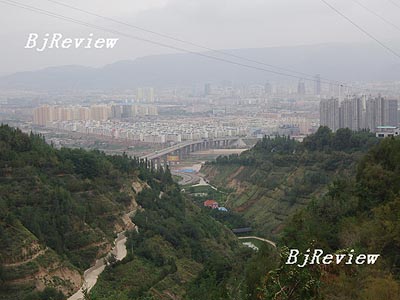|

For thousands of years, Lanzhou City of northwestern Gansu Province had been known as an important desert oasis along the Silk Road, which connected China with south, west and central Asia and Europe. Yet in the last 100 years, this industrial city has been planting trees and cleaning up industrial pollution. In recent years, the city has launched a project of reforesting the two mountains skirting the city from the north and south, in what local people call the "project of life."
As an inland city with a typical semi-arid continental monsoon climate, Lanzhou has a small average annual rainfall of 33 cm while its annual evaporation has reached 144 centimeters. Moreover, the two mountains adjacent to the city are basically rocky, with fairly thin soil layers. These natural conditions have posed serious challenges to the forestation of these two deserted mountains.
"In the 1940s and 1950s, Lanzhou was attacked by sandstorms severely," said Li Zhengping, Vice Director of the "project of life."
However, over the last 50 years generations of Lanzhou people have devoted themselves to planting trees, achieving a total green area of 39,000 hectares on these two mountains, with a remaining 14,000 hectares to be covered with grass or trees. Now the plant varieties on these two mountains have reached 248. The mountains have also become the habitat for 76 breeds of vertebrates and 55 types of birds, which together with the natural environment, form a complete ecosystem.
Over 20 forest parks have been built on these two mountains, covering a total area of more than 1,300 hectares. Li said during the weeklong holidays over May Day and National Day, these parks are visited by hundreds of thousands of people, many of who are residents of Lanzhou. This is the proof that the two formerly deserted mountains have turned into local people's top choice for excursions out of the city.
A cause lasting centuries
The dream of greening the two mountains started over 180 years ago when China was still under the reign of the Qing Dynasty (1644-1911). During those days, local people created cellars to store water for trees.
In the summer of 1942, the desertification of the two mountains grabbed the attention of the central authorities. Between 1943 and 1949, a huge sum of money was earmarked for greening Lanzhou every year.
Henry Agard Wallace, then Vice President of the United States, paid a visit to China in 1944. He traveled to Lanzhou, launched experimental greening projects on the two arid mountains and distributed honeydew seeds, which appeared like a new type of melon to Chinese people. A monument in memory of Wallace has been mounted among the lush foliage on the land where he initiated the greening projects.
Shortly after the founding of the People's Republic of China in 1949, the Central Government enlisted a large number of college and university graduates in big cities to participate in the development of China's vast and backward northeastern areas. The lack of basic infrastructure led the young people to desperate measures. Together with Lanzhou residents they carried chunks of ice on their backs and buried it in holes dug on the two mountains so that melted ice could supply water for the trees. The strategy eventually failed due to huge evaporation of water.
In 1983, the Lanzhou Municipal Government initiated a new greening project, contracting the forestation of the 10,000-hectares of land on the two mountains to over 300 government agencies and companies. These contractors were given the duty to plant trees on their lots but also had the right to enjoy all the products yielded on their land. By 1999, the new strategy had yielded forests of 9,300 hectares, which had a total of 32 million trees.
The green cause gained new impetus in October 1999 during a visit of then Chinese Premier Zhu Rongji to Lanzhou. At an observation booth in a forest park that overlooked the city, Zhu was greatly worried by the view of Lanzhou surrounded by almost bald mountains. He decided on the spot to increase financing from the Central Government to Lanzhou's greening projects. Between 2001 and 2003, the Ministry of Finance injected a total of 600 million yuan into the greening projects on Lanzhou's two mountains.
|
.jpg)
.jpg)